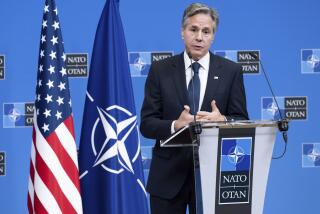Pentagon’s Challenge
- Share via
Most conversations on future defense plans for Europe start with the difficulty of getting 15 very different member nations of the North Atlantic Treaty Organization to line up behind a single sensible strategy.
That is a serious problem, ranking somewhere below the painful task of getting the loose alliance of very different fighting forces that constitute the U.S. Defense Department to line up behind a single sensible strategy of their own, for Europe and elsewhere in the world where American interests are at stake.
For at least two decades the Pentagon has dodged what should be an obvious condition of getting the weapons that it wants--describing the kinds of fights that its forces were likely to get into anywhere in the world and matching the descriptions with weapons and tactics designed to prevail if fighting actually broke out. Caspar W. Weinberger ran the Pentagon as though he expected to have to fight everyone, everywhere, at the same time, and bought weapons as though that danger was real.
A requirement that the defense secretary send a revised five-year defense plan to Congress each year does not help because the document is budget-oriented, tending to argue for money to support whatever forces are in place rather than explain why the forces exist in the first place.
Soviet President Mikhail S. Gorbachev’s plan to withdraw crack Soviet troops from Eastern Europe has increased the urgency of the Pentagon’s need to be smarter than that. His announcement at the United Nations also makes it plain that it is Washington’s turn to come up with a creative step toward better relations between the superpowers.
It will not do, for example, for Washington to shrug off Moscow’s concept of replacing offensive forces along the East-West border in Europe as so much talk. Assuming that Gorbachev goes through with his plan--and there is no reason to suppose that he will not--the withdrawal of paratroopers, bridge-building units and tanks would indeed reduce Soviet offensive capabilities in the area.
Getting a united front at the Pentagon is essential to coming up with a positive response to Gorbachev in Europe. President-elect George Bush can properly plead that his new Administration needs time to get familiar with the controls and read the fine print on foreign policy. But even before he takes the oath, Bush must be comfortable that his armed services have given some thought to what he can safely propose as a creative next step in arms or troop control and what might get the country into hot water.
His nominee as defense secretary, former Sen. John G. Tower of Texas, spoke the right words in his press conference last week. Two of his most important missions, he said, would be “defining national objectives” and assigning and equipping military forces for “specific missions . . . to carry out the national objectives.”
In the broadest sense, that is what Gorbachev is doing. He needs to divert to consumer goods some of the money and manpower that his country is now pouring into military forces. The “national objective” of those forces has been to keep control of the immense Soviet border against all comers. Afghanistan showed the mission to be clearly beyond the Soviet military’s capability in that part of the world. There is increasing cause to wonder whether it might also fail in Europe. So Gorbachev has relieved his military of some of its responsibilities for protecting the borders and turned them over to political departments, including the Foreign Ministry.
Bush should insist that Tower’s “right words” include a broad evaluation of national objectives along similar lines so that some global interests might be served with more emphasis on political means than on military. He must also insist on knitting the American armed forces more closely together on strategy and making the clear definition of military missions no less important than the trimming of military spending.
More to Read
Sign up for Essential California
The most important California stories and recommendations in your inbox every morning.
You may occasionally receive promotional content from the Los Angeles Times.










